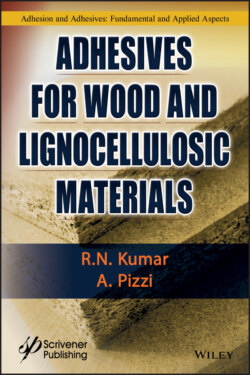Читать книгу Adhesives for Wood and Lignocellulosic Materials - R. N. Kumar - Страница 30
1.5.1.1 Penetration in Different Size Scales
ОглавлениеLaborie proposed a categorization of adhesive penetration in wood in terms of different size scales of adhesive penetration [32]. Accordingly, in the following classification, four scales of penetration are envisioned:
1 Macroscopic penetration (millimeters)
2 Microscopic penetration (microns to tens of microns)
3 Nanoscale penetration (nanometers to tens of nanometers)
4 Angstrom scale penetration (up to tens of angstroms)
Wood as a porous, cellular material displays roughness on the micron scale but can also exhibit roughness on the millimeter scale, depending on how a particular wood element to be bonded is produced. For example, production of rotary-peeled veneer can produce roughness on a millimeter scale due to the creation of lathe checks. Pores or free volume also occur within the amorphous regions of the cell wall material on the molecular level. The length scales over which the wood–adhesive interactions occur are given in Table 1.2 [36].
Table 1.2 Comparison of wood–adhesive interactions relative to length scale.
| Component | μm | nm |
| Adhesive force | 0.0002–0.0003 | 0.2–0.3 |
| Cell wall pore diameter | 0.0017–0.002 | 1.7–2.0 |
| PF resin molecular length | 0.0015–0.005 | 1.5–5.0 |
| Diameter of particles that can pass through a pit | 0.2 | 200 |
| Tracheid lumen diameter | 4–25 | |
| Glue line thickness | 50–250 |
In order to understand the adhesion phenomenon operating at different size scales in wood, the values of size scales shown in Table 1.2 should be viewed in conjunction with the length scale (as shown in Table 1.3) [37] over which different wood–adhesive interactions take place.
Table 1.3 Comparison of adhesion interactions relative to length scale [36].
| Category of adhesion mechanism | Type of interaction | Length scale |
| Mechanical | Interlocking or entanglement | 0.01–1000 μm |
| Diffusion | Interlocking or entanglement | 10 nm-2 nm |
| Electrostatic | Charge | 0.1–1.0 μm |
| Covalent bonding | Charge | 0.1–0.2 nm |
| Acid-base interaction | Charge | 0.1–0.4 nm |
| Lifshitz van der Waals | Charge | 0.5–1.0 |
In its most simple approach, adhesive penetration can be measured in terms of depth of penetration. It typically spans from fractions of millimeters to several millimeters. One may therefore term this scale of penetration as macroscopic penetration.
A finer observation scale of adhesive domains can be understood by reference to wood anatomy. Hierarchically structured wood is an orthotropic material, in which arrays of cells are aligned along the longitudinal and radial directions (Figure 1.9).
Figure 1.9 Arrays of cells aligned along the longitudinal and radial directions.
In the case of wood cells, cell lumen dimensions thus fall on the micron range. Perforation plates at the cell extremities and pits on the lateral cell walls constitute additional cavities between adjacent cells. Such cavities have diameters in the order of microns and may thus be termed “micropores”. A microscopic porous network consequently imparts flow pathways within a solid wood block. It follows that adhesive penetration into cell lumens and “micropores” falls into the dimensional domain of microscopic penetration. As expected, microscopic penetration is best evaluated with microscopic techniques. Optical microscopy and scanning and transmission electron microscopy (SEM/TEM) have been utilized with success to probe adhesive microscopic penetration [31, 34, 35, 38].
Adhesive variables (MW distribution), substrate variables (wood surface roughness and moisture content), and processing variables (adhesive cure method) influence microscopic penetration of adhesives in wood [31, 38]. Wood surface energy and adhesive surface tension are also important parameters of micron-scale penetration [39].
